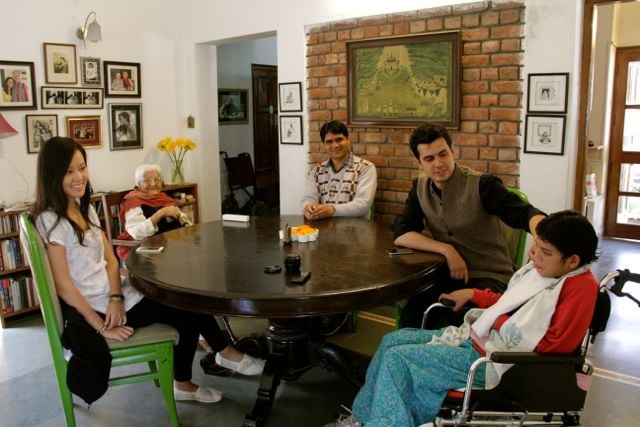Matthew, who has a mental handicap, has five brothers and sisters. The other children get quite a few treats because of him through gestures of kindness offered by local organizations. A free afternoon at the fair, for example, or tickets to the circus: “For the handicapped and their families.” There is never any shortage of volunteers to ride shotgun with him for these fun events. After one such enjoyable outing, his sister Sophie asked her mother in conspiratorial tones: “What happens if they ever find out that Matty isn’t really handicapped?”
Matty isn’t really handicapped, at least according to Sophie. He’s just Matty, her older brother, whom she has known her entire life. She’s not above making the most of what other people perceive, but in her own mind, she knows the score. And the truth is: Matty isn’t really handicapped.
I was reminded of this story yesterday while listening to an NPR (National Public Radio) interview with Ian Brown, author of “The Boy in the Moon” a memoir of his life with his severely handicapped son, Walker.
Walker, like my daughter Moy Moy, has difficulty swallowing so he eats through a tube. It was surgically inserted directly into his tummy. I laughed out loud when I heard Ian Brown describing the difficulties of tube feeding:
Terry Gross: Since he can’t swallow and has to be fed with a tube, describe what feeding him is like.
Mr. Brown: Well, (we had) to hook him up . . . it was very complicated. He’d be asleep, and you had to hang a feed bag up on an IV stand, and that was a gravity-fed thing, through a little lock in the tube.
And the tube then would go down through his sleeper, a hole that you would cut in his sleeper, into this little Mickey valve, they call it a Mickey, that is permanently in his side. And it has a little stopper in it.
So you connect that up, and you turn the pump on, and then it would slowly feed him throughout the night. But, you know, if he woke up, and he started hitting himself, then, you know, you’ve got to do everything in reverse. You’ve got to turn off the pump, you’ve got to lock the little – the line so that the stuff that’s in the line doesn’t come shooting out, which I, you know, constantly forgot.
You’ve got to unzip the sleeper to get into the Mickey to undo the Mickey then take it out, out through the hole, hang it up so it doesn’t drop onto the floor. You know, then you’ve got to pick him up and take him downstairs and give him a bottle because though he can’t really swallow without aspirating, the bottle seems to calm him down a little.
Right.
Moy Moy has a tube in her tummy too. And for the first three days post-surgery, we also found the whole process mystifying, challenging and unbelievably difficult. Then we got used to it. Three days. Now I know how to unclog the tube when it gets stuck and how to tell when she is about to cough and spurt the contents of her tummy into my face. I know how to remove the tube and how to insert a new one (which I was originally informed could only be done by a surgeon). And we don’t have the new-fangled, even simpler system that the Browns did for their son, with a gravity-fed automatic process or a Mickey button with a little valve.
It’s e-a-s-y. Definitely easier than spoon-feeding a child who has trouble swallowing and worlds more convenient when it comes to administering medicines. But it’s fun to shroud the whole thing in mystery. I’ve done it too, so I don’t blame Ian Brown. The average reader of his newspaper or the listening public at NPR has no idea what tube feeding involves so it’s simple to impress them and simpler still to create an image of parents struggling bravely and poignantly to care for their poor disabled child. I know, I know.
But I also know that most of us parents have worked out a system. Most of us have back ups and safety nets and ways to get around just about anything. At least those of us who are writing books, essays and blogs.
So what motivates us? Why do we like to make things sound more difficult than they are? Why do we need to make what we do seem more dramatic, more enormous, more fraught?
I think we are worried that people will forget us. I think we are afraid that because we make it look easy, people will think that it IS easy.
It’s easy to pour formula down a tube – once. It’s easy to change a nappy – once. It’s easy, even appealing, to wriggle out of an event we don’t really want to attend by saying “It’s just too difficult. I’ve got a child with special needs.” Everyone nods; everyone sympathizes. No one understands that moments become years, that the work of a day can stretch into a lifetime and that while taken one at a time, each act is manageable, added up and tallied, they all amount to nothing. We feel we have nothing to show for ourselves. Nappies changed; feeds given. Years gone. Decades.
 My friend Natasha Badhwar says “Days are long, months feel safe. But the years, the years seem to be on the run.” We are chasing our years, we are running after our lives, we are hoping that they really do amount to something, that all we are pouring out for these children we love so dearly, so helplessly, is adding up to something significant.
My friend Natasha Badhwar says “Days are long, months feel safe. But the years, the years seem to be on the run.” We are chasing our years, we are running after our lives, we are hoping that they really do amount to something, that all we are pouring out for these children we love so dearly, so helplessly, is adding up to something significant.
Please forgive us when we overreach. We know we are doing it. We know there is nothing heroic about the one tube feed, the one nappy, the one night of broken sleep.
It’s the years. The years. The long, long avenue of years.


